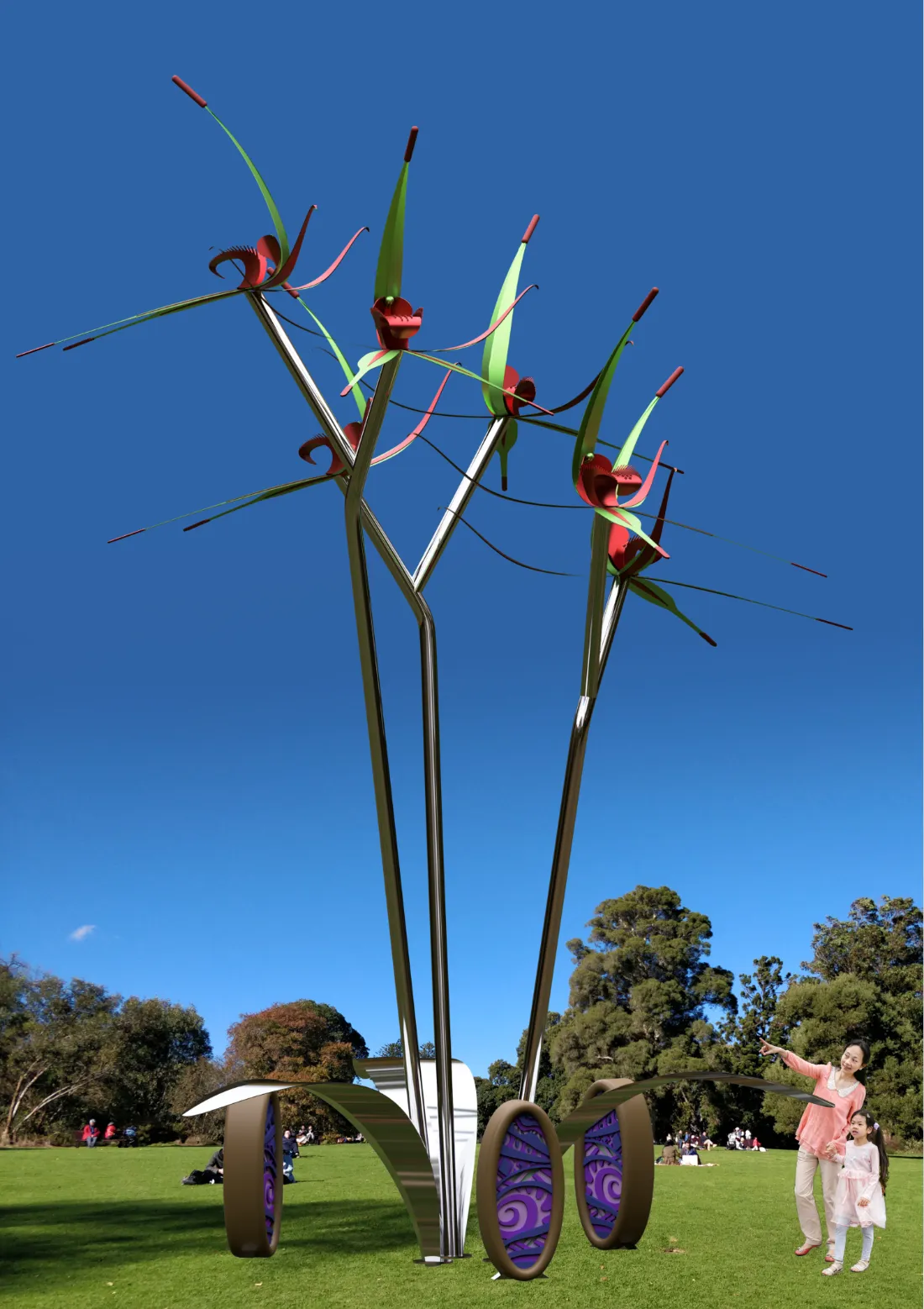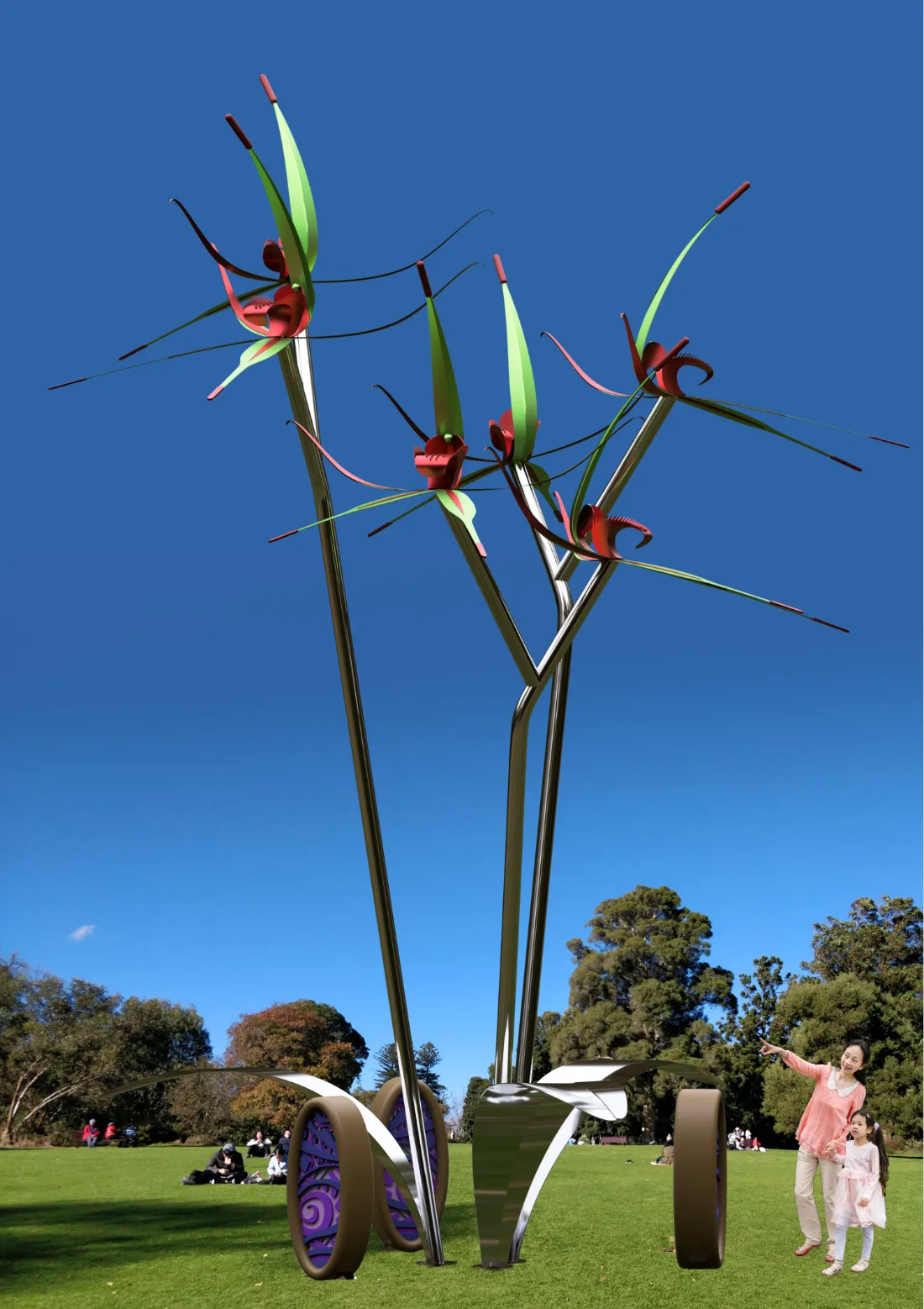View version 1 of the Spider Orchid




Shield designs by Adam Magennis

The towering chrome Frankston Spider Orchid will create a spectacle for drivers on the Peninsula Link freeway and invite viewers to connect with local Bunurong culture that traditionally protected, managed and harvested the tubers from the orchid. The orchid with its three stems and six flowers is inspired by the symbolic importance of these numbers which represent the seasons and elements on Bunurong Country.
Caladenia robinsonii is endemic to the region and one of the most threatened orchids in Australia, with one small population remaining in nearby Rosebud.
Local Bunurong artist Adam Magennis has integrated Bunurong cultural designs in scar shields around the base of the orchid, influenced by the local ecology, geology, dreaming tracks that shape the country, and other cultural symbols.
The scar shields will feature bright slabs of bold and uplifting colour, utilising industrial recycled plastic, embracing the theme of sustainability. Although widely used outdoors, this will be the first sculptural use in Australia.
A Bunurong Cultural Landscape Garden will include low maintenance local plants of the Mornington Peninsula, which are associated with the six Bunurong seasons and will provide colour throughout the year. Weeping grass in particular has a symbiotic relationship with the Frankston Spider Orchid.
The Frankston Spider Orchid
Caladenia robinsonii is endemic to the region, and was first formally classified after samples were collected from north Frankston. It is listed as critically endangered and is one of the most threatened orchids in Australia, with one small population of less than 100 plants remaining in nearby Rosebud. There is a government Recovery Plan for the orchid, and a local group dedicated to saving this species.
There was once a variety of orchids across the Frankston sandy heath woodlands country that formed their own distinct colonies and family clumps throughout the landscape. These orchid colonies were traditionally harvested as a food resource for the Boon wurrung community.
This map shows the only areas left where this species may occur. The sculpture location and McClelland sculpture park are located near the centre of one of the areas of the orchid’s possible range. Reference

Cultural permissions
Adam will undertake the process of consultation and obtaining correct permissions from the Bunurong Land Council Aboriginal Corporation. This will be with regards to any proposed Bunurong language used and proposed Bunurong concepts and designs before the work is manufactured. There will be at least two meetings. Adam is an independent Bunurong artist and has the support of the Bunurong Land Council Aboriginal Corporation for undertaking Bunurong art projects on Bunurong Country.
Opening ceremony
An opening ceremony will be culturally facilitated by a Bunurong First Peoples community member, preferably a Bunurong person and member of the Bunurong Land Council Aboriginal Corporation (BLCAC).
The BLCAC is the Registered Aboriginal Party that represents Bunurong Country, Bunurong People and Bunurong Culture.The opening ceremony will include a Welcome to Country and Traditional Bunurong Smoking Ceremony which includes burning Wattle, Mannah Gum and Cherry Ballart.
Symbolism of three
The number three is represented and found in various environment elements on Bunurong Country. At a macro level, the biosphere forms Bunurong Country and has three elements called the lithosphere, atmosphere and hydrosphere.
At a micro level, there are three main geological features that create the topography of Bunurong being granites, basalts and limestones. Three can be generally seen in the stages of a plant cycle, commencing from the seed germination, growth to pollination.
When making a cultural scar in a tree, there are three layers that heal the wound of the tree being the bark layer, phloem layer and cambium layer. Mountain peaks generally appear in three across Bunurong country.
Tool production and making of spears, axes, boomerangs and stone tools generally comprises three activities. The winter constellation of scorpius is mapped by groups of three stars. This constellation maps the shape of Nairms coastline along Bunurong Country.
For this installation, the three scar shields showcase the number three on Bunurong Country and the use of the Frankston Spider Orchid has three cycles being emergence of annual terrestrial, flowering stage and germination prior to the orchid going dormant until the next wildflower season. The sculpture has three stems, and six flowers.
Landscape Garden
The Bunurong Cultural Design will also incorporate a Bunurong Cultural Landscape Garden around the Bunurong Scar Shields and Frankston Spider Orchid installation.
The Bunurong Cultural Landscape Garden will include low maintenance local plants of the Mornington Peninsula that don’t require regular pruning and are adaptable to various soil conditions.
These plants include the running postman, small leaved clematis, noon flower, kangaroo grass, weeping grass, wallaby grass, yam daisy, morning star and chocolate lilies.
The purpose of these selected plants is that they are associated with the six Bunurong seasons and provide colour throughout the year. Weeping grass in particular has a symbiotic relationship with the Frankston Spider Orchid.
These plants also contribute to the localised seed bank in the area and were culturally located along Bunurong Song Lines and Dreaming Tracks.
It is proposed that the Bunurong Cultural Landscape Garden is in the shape of a number of raised mounds (similar to a raised vegetable patch) ontop of the existing gravel and concrete. The raised mounds act as a vibrant environmental feature and will provide enough substrate to support the flora.
The raised mound shape also represents Bunurong agricultural practice, where raised mounds containing native food and medicine plants were a common ecological feature within the environment prior to European farming being introduced into Australia.
Multi-dimensional
The artwork is designed to provide different experiences from variable distances, giving the work depth of experience for the audience.
From a car on Peninsula Link freeway
The viewer will see the piece in its entirety, and be able to appreciate the beautiful aesthetics of the orchid’s form and colours.
From a car on Cranbourne road (and from intersection and shopping complex opposite )
The viewer will experience the scale and volume of the work filling the sky, and see the finer details of the intricate flowers.
They will be able to see an indication of the graphic design on the scar shields, encouraging them to visit the work to view the details.
Close up
The viewer will be immersed in the volume of the structure, with the flowers above them. They will be able to see the intricate details of Adam’s graphic design work and enjoy the details of the cultural garden.
Public safety
Climbing is the biggest public risk for a work like this, and safety is a key element of this design. The stems are far enough apart that cannot be used together to climb. The polished stainless steel stems will be slippery and have no footholds, making climbing impossible without assistance or implements. The height of the leaves (2000mm) have been designed to conform with Australian playground specifications and are below a “Free Height of Fall” of 3000mm.
Traffic Safety
The sculpture does not use red or green at the eye level of a driver. There are no flat panels of polished materials at eye level that could reflect concentrated light into a driver’s eyes. The pale green and dark red colours are well above the line of sight for the traffic lights, so they will not distract from the traffic light function and safety.
We will work with the painters to choose colours that are not similar to the traffic light colours, and will get the final palette approved before painting to ensure the colours present no risk.
Engineering
Our team engineer will ensure that all structural aspects and materials are optimised for safety during design, build and installation phases. Our engineer will produce a report validating the construction methodology and materials, prior to construction for the selected artwork commission.
The structure, leaves, scar shields and the flower heads will be separately load tested post manufacture to ensure the structural integrity, including testing for potential wind loads.
Lighting
The lighting we recommend consists of three simple white flood lights that are positioned at ground level These flood lights will point upwards illuminating the stems and flowers from below. This technique is commonly used to illuminate trees. The lights will need to be enclosed in a security box to protect from vandalism.
Resisting graffiti
All surfaces are graffiti resistant.
